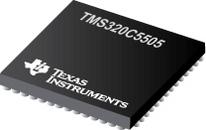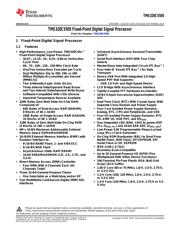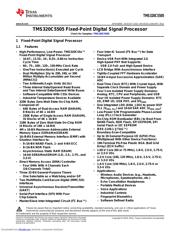Part Datasheet Search > - > TMS320C5505 Datasheet PDF

Images are for reference
TMS320C5505 Datasheet PDF
Part Series:
TMS320C5505 Series
Category:
-
Description:
the tms320c5505 is a member of ti s tms320c5000 fixed-po t digital signal processor (dsp) product family and is desig...
Updated Time: 2023/01/13 03:20:19 (UTC + 8)
TMS320C5505 - Datasheet PDF
TMS320C5505 Datasheet PDF -
TMS320C5505 - TI Specifications
TYPE
DESCRIPTION
Case/Package
NFBGA-196
show more
TMS320C5505 - TI Function Overview
●The device is a member of TI"s TMS320C5000™ fixed-point Digital Signal Processor (DSP) product family and is designed for low-power applications.
●The fixed-point DSP is based on the TMS320C55x™ DSP generation CPU processor core. The C55x™ DSP architecture achieves high performance and low power through increased parallelism and total focus on power savings. The CPU supports an internal bus structure that is composed of one program bus, one 32-bit data read bus and two 16-bit data read buses, two 16-bit data write buses, and additional buses dedicated to peripheral and DMA activity. These buses provide the ability to perform up to four 16-bit data reads and two 16-bit data writes in a single cycle. The device also includes four DMA controllers, each with 4 channels, providing data movement for 16-independent channel contexts without CPU intervention. Each DMA controller can perform one 32-bit data transfer per cycle, in parallel and independent of the CPU activity.
●The C55x CPU provides two multiply-accumulate (MAC) units, each capable of 17-bit x 17-bit multiplication and a 32-bit add in a single cycle. A central 40-bit arithmetic/logic unit (ALU) is supported by an additional 16-bit ALU. Use of the ALUs is under instruction set control, providing the ability to optimize parallel activity and power consumption. These resources are managed in the Address Unit (AU) and Data Unit (DU) of the C55x CPU.
●The C55x CPU supports a variable byte width instruction set for improved code density. The Instruction Unit (IU) performs 32-bit program fetches from internal or external memory and queues instructions for the Program Unit (PU). The Program Unit decodes the instructions, directs tasks to the Address Unit (AU) and Data Unit (DU) resources, and manages the fully protected pipeline. Predictive branching capability avoids pipeline flushes on execution of conditional instructions.
●The general-purpose input and output functions along with the 10-bit SAR ADC provide sufficient pins for status, interrupts, and bit I/O for LCD displays, keyboards, and media interfaces. Serial media is supported through two MultiMedia Card/Secure Digital (MMC/SD) peripherals, four Inter-IC Sound (I2S Bus™) modules, one Serial-Port Interface (SPI) with up to 4 chip selects, one I2C multi-master and slave interface, and a Universal Asynchronous Receiver/Transmitter (UART) interface.
●The device peripheral set includes an external memory interface (EMIF) that provides glueless access to asynchronous memories like EPROM, NOR, NAND, and SRAM, as well as to high-speed, high-density memories such as synchronous DRAM (SDRAM) and mobile SDRAM (mSDRAM). Additional peripherals include: a high-speed Universal Serial Bus (USB2.0) device mode only, and a real-time clock (RTC). This device also includes three general-purpose timers with one configurable as a watchdog timer, and an analog phase-locked loop (APLL) clock generator.
●In addition, the device includes a tightly-coupled FFT Hardware Accelerator. The tightly-coupled FFT Hardware Accelerator supports 8 to 1024-point (in power of 2) real and complex-valued FFTs.
●The device includes one integrated LDO (ANA_LDO) to provide regulated 1.3 V to the DSP PLL (VDDA_PLL) and 10-bit SAR ADC(VDDA_ANA).
●Note:
● ANA_LDO can only provide a regulated 1.3 V. When the DSP PLL requires 1.4 V (PLLOUT > 120 MHz), an external supply is required to supply 1.4 V to the DSP PLL (VDDA_PLL).
●The device is supported by the industry’s award-winning eXpressDSP™, Code Composer Studio™ Integrated Development Environment (IDE), DSP/BIOS™, Texas Instruments’ algorithm standard, and the industry’s largest third-party network. Code Composer Studio IDE features code generation tools including a C Compiler and Linker, RTDX™, XDS100™, XDS510™, XDS560™ emulation device drivers, and evaluation modules. The device is also supported by the C55x DSP Library which features more than 50 foundational software kernels (FIR filters, IIR filters, FFTs, and various math functions) as well as chip support libraries.
● High-Performance, Low-Power, TMS320C55x™ Fixed-Point Digital Signal Processor
● 16.67-, 13.33-, 10-, 8.33-, 6.66-ns Instruction Cycle Time
● 60-, 75-, 100-, 120-, 150-MHz Clock Rate
● One/Two Instructions Executed per Cycle
● Dual Multipliers [Up to 200, 240, or 300 Million Multiply-Accumulates per Second (MMACS)]
● Two Arithmetic/Logic Units (ALUs)
● Three Internal Data/Operand Read Buses and Two Internal Data/Operand Write Buses
● Software-Compatible With C55x Devices
● Industrial Temperature Devices Available
● 320K Bytes Zero-Wait State On-Chip RAM, Composed of:
● 64K Bytes of Dual-Access RAM (DARAM), 8 Blocks of 4K x 16-Bit
● 256K Bytes of Single-Access RAM (SARAM), 32 Blocks of 4K x 16-Bit
● 128K Bytes of Zero Wait-State On-Chip ROM
●(4 Blocks of 16K x 16-Bit)
● 4M x 16-Bit Maximum Addressable External Memory Space (SDRAM/mSDRAM)
● 16-/8-Bit External Memory Interface (EMIF) with Glueless Interface to:
● 8-/16-Bit NAND Flash, 1- and 4-Bit ECC
● 8-/16-Bit NOR Flash
● Asynchronous Static RAM (SRAM)
● 16-bit SDRAM/mSDRAM (1.8-, 2.5-, 2.75-, and 3.3-V)
● Direct Memory Access (DMA) Controller
● Four DMA With 4 Channels Each (16-Channels Total)
● Three 32-Bit General-Purpose Timers
● One Selectable as a Watchdog and/or GP
● Two MultiMedia Card/Secure Digital (MMC/SD) Interfaces
● Universal Asynchronous Receiver/Transmitter (UART)
● Serial-Port Interface (SPI) With Four Chip-Selects
● Master/Slave Inter-Integrated Circuit (I2C Bus™)
● Four Inter-IC Sound (I2S Bus™) for Data Transport
● Device USB Port With Integrated 2.0 High-Speed PHY that Supports:
● USB 2.0 Full- and High-Speed Device
● LCD Bridge With Asynchronous Interface
● Tightly-Coupled FFT Hardware Accelerator
● 10-Bit 4-Input Successive Approximation (SAR) ADC
● Real-Time Clock (RTC) With Crystal Input, With Separate Clock Domain and Power Supply
● Four Core Isolated Power Supply Domains: Analog, RTC, CPU and Peripherals, and USB
● Four I/O Isolated Power Supply Domains: RTC I/O, EMIF I/O, USB PHY, and DVDDIO
● One integrated LDO (ANA_LDO) to power DSP PLL (VDDA_PLL) and 10-bit SAR ADC (VDDA_ANA)
● Low-Power S/W Programmable Phase-Locked Loop (PLL) Clock Generator
● On-Chip ROM Bootloader (RBL) to Boot From NAND Flash, NOR Flash, SPI EEPROM, SPI Serial Flash or I2C EEPROM
● IEEE-1149.1 (JTAG)
●Boundary-Scan-Compatible
● Up to 26 General-Purpose I/O (GPIO) Pins
●(Multiplexed With Other Device Functions)
● 196-Terminal Pb-Free Plastic BGA (Ball Grid Array) (ZCH Suffix)
● 1.05-V Core (60 or 75 MHz), 1.8-V, 2.5-V, 2.75-V, or 3.3-V I/Os
● 1.3-V Core (100, 120 MHz), 1.8-V, 2.5-V, 2.75-V, or 3.3-V I/Os
● 1.4-V Core (150 MHz), 1.8-V, 2.5-V, 2.75-V or 3.3-V I/Os
●All trademarks are the property of their respective owners. All trademarks are the property of their respective owners.
show more
Part Datasheet PDF Search
Example: STM32F103
Loading...
72,405,303 Parts Datasheet PDF, Update more than 5,000 PDF files ervery day.



